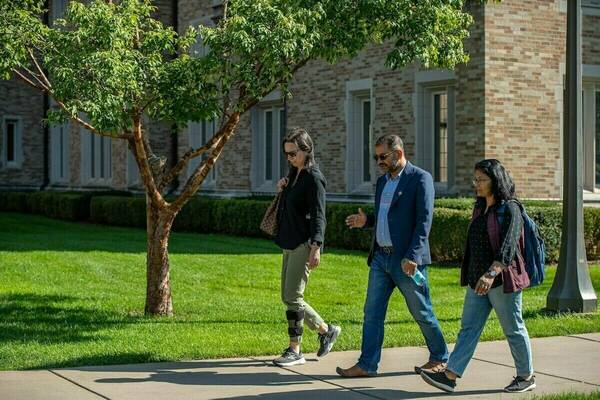Women of African ancestry may be biologically predisposed to early onset or aggressive breast cancers
While the incidence of breast cancer is highest for white women, Black women are more likely to have early-onset or more aggressive subtypes of breast cancer, such as triple-negative breast cancer. Among women under 50, the disparity is even greater: young Black women have double the mortality rate of young white women.
Now research from the University of Notre Dame is shedding light on biological factors that may play a role in this disparity. The study published in iScience found that a population of cells in breast tissues, dubbed PZP cells, send cues that prompt behavioral changes that could promote breast cancer growth.
Funded by the National Cancer Institute at the National Institutes of Health, the study set out to explore what biological differences in breast tissue could be related to early onset or aggressive breast cancers. Most breast cancers are carcinomas, or a type of cancer that develops from epithelial cells. In healthy tissue, epithelial cells form linings in the body and typically have strong adhesive properties and do not move.
The researchers focused on PZP cells as previous studies had shown that these cells are naturally and significantly higher in healthy breast tissues of women of African ancestry than in healthy breast tissues of women of European ancestry. While PZP cell levels are known to be elevated in breast cancer patients in general, their higher numbers in healthy, African ancestry tissues could hold clues to why early-onset or aggressive breast cancers are more likely to occur in Black women.
“The disparity in breast cancer mortality rates, particularly among women of African descent, is multifaceted. While socioeconomic factors and delayed diagnosis may be contributing factors, substantial emerging evidence suggests that biological and genetic differences between racial groups can also play a role,” said Crislyn D'Souza-Schorey, the Morris Pollard Professor of Biological Sciences at Notre Dame and corresponding author of the study.
The study showed how PZP cells produce factors that activate epithelial cells to become invasive, where they detach from their primary site and invade the surrounding tissue.

For example, a particular biological signaling protein known as AKT is often overactive in breast cancers. This study showed that PZP cells can activate the AKT protein in breast epithelial cells, which in part allows them to invade the surrounding environment. PZP cells also secrete and deposit certain proteins outside the cell that guide the movement of breast epithelial cells as they invade.
Overall, the results of the study emphasize multiple mechanisms by which PZP cells may influence the early stages of breast cancer progression and their potential contribution to disease burden.
The researchers also looked at how a targeted breast cancer drug, capivasertib, which inhibits the AKT protein, impacted PZP cells and found it markedly reduced the effects of the PZP cells on breast epithelial cells.
“It’s important to understand the biological and genetic differences within normal tissue as well as tumors among racial groups, as these variations could potentially influence treatment options and survival rates. And consequently, in planning biomarker studies, cancer screenings or clinical trials, inclusivity is important,” said D'Souza-Schorey, also an affiliate of Notre Dame’s Berthiaume Institute for Precision Health and Harper Cancer Research Institute.
D'Souza-Schorey and her lab collaborated with the Indiana University Melvin and Bren Simon Comprehensive Cancer Center’s Susan G. Komen Tissue Bank to access PZP cells and epithelial cells isolated from healthy breast tissues of both African and European ancestry. The cell lines were then grown in a three-dimensional environment, mimicking the way the cells would behave in living tissues and organs.
The research team also worked with the Notre Dame Integrated Imaging Facility for the study.
In addition to D’Souza-Schorey, co-authors include Madison Schmidtmann, Victoria Elliott, James W. Clancy, and Zachary Schafer from Notre Dame and Harikrishna Nakshatri from and IU Simon Comprehensive Cancer Center.
Contact: Brandi Wampler, associate director of media relations, 574-631-2632, brandiwampler@nd.edu
Originally published by at news.nd.edu on July 24, 2025.
Latest Research
- Crossing borders with NDG grants: Engineering professor brings his research—and passion for fruit flies—to MexicoOfficially, Jeremiah Zartman studies and teaches about human health as an associate professor of chemical and biomolecular engineering at Notre Dame. Unofficially, he’s a passionate advocate for fruit flies. His fascination began during his time at Princeton, where Notre Dame alumnus and Nobel Prize…
- To prevent deliveries from disappearing from porches, Napoleon Suarez ’04 thinks outside the box.…
- No credit history? You might have another way to prove creditworthinessNew research from Notre Dame marketing professor Joonhyuk Yang reveals how retail transaction data can be used to create reliable credit scores for individuals without formal credit histories.
- Twenty-two Notre Dame students selected for 2025-26 Fulbright U.S. Student ProgramTwenty-two University of Notre Dame students have been named finalists for the 2025-26 Fulbright U.S. Student Program, with another seven singled out as alternates for the award. The finalists include 18 undergraduate students and four graduate students.
- From Notre Dame to Nepal: Notre Dame’s Research Communications Lead Builds New Collaborations with Kathmandu UniversityWith over 7,000 miles between them, the University of Notre Dame and Kathmandu University (KU) in Nepal stand a world apart, geographically. Take a closer look, though, and you will notice a few surprising similarities. Both are situated in and around sacred spaces…
- NDISC Students Study the American Revolution and Modern Navy with ROTC and Naval Academy Cadets and MidshipmenIn the second iteration of the Notre Dame-Naval Academy collaborative staff ride, students and staff participated in a two-week series of historic site visits and character presentations centered around the American Revolutionary War as well as visited modern military facilities to gain a better understanding of the various Navy communities and broader military joint capabilities.













